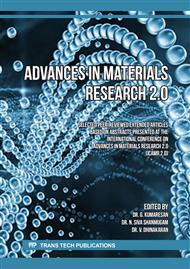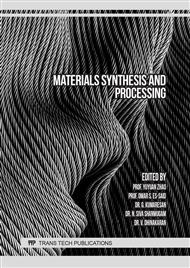[1]
Chao Cai, Shan He, Lifan Li, Qing Teng, Bo Song, Chunze Yan, Qingsong Wei, Yusheng Shi, In-situ TiB/Ti-6Al-4V composites with a tailored architecture produced by hot isostatic pressing: Microstructure evolution, enhanced tensile properties and strengthening mechanisms, Composites Part B. 164 (2019) 546–558.
DOI: 10.1016/j.compositesb.2019.01.080
Google Scholar
[2]
K. Morsi, V.V Patel, 2007 Processing and properties of titanium-titanium boride (TiBw) matrix composites-a review, J Mater Sci. 42 (2007) 2037–47.
DOI: 10.1007/s10853-006-0776-2
Google Scholar
[3]
S.C. Tjong, Z.Y. Ma, Microstructural and mechanical characteristics of in situ metal matrix composites, Materials Science and Engineering. 29 (2000) 49-113.
DOI: 10.1016/s0927-796x(00)00024-3
Google Scholar
[4]
G. Rousset, E. Martin, J. Lamon, In situ fibre strength determination in metal matrix composites, Composites Science and Technology. 69 (2009) 2580–2586.
DOI: 10.1016/j.compscitech.2009.07.020
Google Scholar
[5]
A.P.I. Popoola, L. Phume, S. Pityana, V.S. Aigbodion, In-situ formation of laser Ti6Al4V–TiB composite coatings on Ti6Al4V alloy for biomedical application, Surface & Coatings Technology. 285 (2016) 161–170.
DOI: 10.1016/j.surfcoat.2015.10.079
Google Scholar
[6]
Z. Xinghong, Z. Chuncheng, Q. Wei, H. Xiaodong, V.L. Kvanin, Self-propagating high temperature combustion synthesis of TiC/TiB2 ceramic-matrix composites, Composites Science and Technology. 62 (2002) 2037-2041.
DOI: 10.1016/s0266-3538(02)00155-0
Google Scholar
[7]
C.G. Chen, J. Luo, Z.M. Guo, W.W Yang, J. Chen, Microstructural evolution and mechanical properties of in situ TiB2/Al composites under high-intensity ultrasound, Rare Metals. 34 (2015) 168.
DOI: 10.1007/s12598-014-0442-9
Google Scholar
[8]
M. Anandajothi, S. Ramanathan, Wear Resistance Improvement of the Ti6al4v/2.5%TiB2-2.5%Tic Composites Fabricated by Powder Metallurgy, International Journal of Recent Scientific Research. 7 (2016) 10862-10866.
Google Scholar
[9]
S.W. Zeng, A.M. Zhao, H.T Jiang, X.Q. Yan, J.X. Liu, X.G. Duan, 2014 High-temperature deformation behavior of titanium clad steel plate, Rare Metals. 34 (2014) 764-769.
DOI: 10.1007/s12598-014-0266-7
Google Scholar
[10]
P. Ravindran, K. Manisekar, R. Narayanasamy, Tribological behaviour of powder metallurgy-processed aluminium hybrid composites with the addition of graphite solid lubricant, ceramic international. 39 (2013) 1169-1182.
DOI: 10.1016/j.ceramint.2012.07.041
Google Scholar
[11]
S. Anbuselvan, S. Ramanathan, Dry sliding wear behavior of hot extruded ZE41A magnesium alloy, Materials Science and Engineering A. 527 (2010) 1815-1820.
DOI: 10.1016/j.msea.2009.11.017
Google Scholar
[12]
Y.S. Mao, L. Wang, K.M. Chen n, S.Q. Wang n, X.H. Cui X.H, Tribo-layer and its role in dry sliding wear of Ti–6Al–4V alloy, Wear. 29 (2013)1032-1039.
DOI: 10.1016/j.wear.2012.11.063
Google Scholar
[13]
B. Choi, I. Kim, Y. Lee, Y. Kim, Microstructure and friction / wear behavior of (TiB + TiC) particulate-reinforced titanium matrix composites, Wear. 318 (2014) 68-77.
DOI: 10.1016/j.wear.2014.05.013
Google Scholar
[14]
Qi An, L.J. Huang, Yang Bao, Rui Zhang, Shan Jiang, Lin Geng, Miaomiao Xiao, Dry sliding wear characteristics of in-situ TiBw/Ti6Al4V composites with different network parameters, Tribology International. 121 (2018) 252–259.
DOI: 10.1016/j.triboint.2018.01.053
Google Scholar
[15]
Bowen Zheng, Fuyu Dong, Xiaoguang Yuan, Hongjun Huang, Yue Zhang, Xiaojiao Zuo, Liangshun Luo, Liang Wang, Yanqing Su, Weidong Li, Peter K. Liaw, Xuan Wang, 2020 Microstructure and tribological behavior of in situ synthesized (TiB+TiC)/ Ti6Al4V (TiB/TiC=1/1) composites, Tribology International. 145 (2020) 106-177.
DOI: 10.1016/j.triboint.2020.106177
Google Scholar
[16]
A. Molinari, G. Straffelini, B. Tesi, T. Bacci, Dry sliding wear mechanisms of the Ti6Al4V alloy, Wear. 208 (1997) 105-112.
DOI: 10.1016/s0043-1648(96)07454-6
Google Scholar



